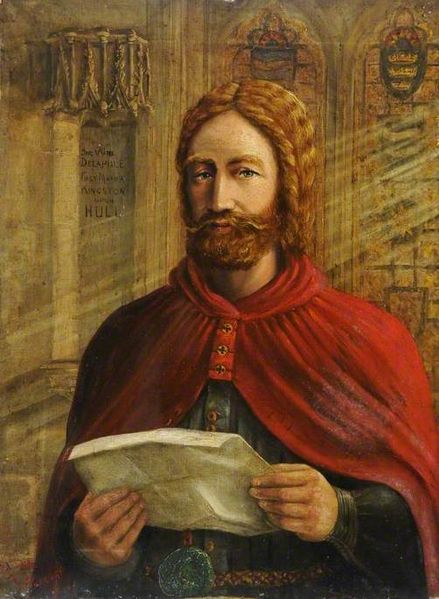http://thekingsandqueens.wordpress.com/2014/03/
William de la Pole, 1st Duke of Suffolk (16th October 1396 – 2nd May 1450) was an English commander during the Hundred Year War and Lord High Admiral of England from 1447 to 1450. He was born at Cotton Suffolk and was second d son of Michael de la Pole, 2nd Earl of Suffolk and Katherine de Stafford, daughter of Hugh de Stafford, 2nd Earl of Stafford and Philippa de Beauchamp.
He was seriously injured during the Siege of Harfleur in 1415. His father also died of dysentery during the siege. Later in that year his elder brother Michael de la Pole, 3rd Earl of Suffolk died at the Battle of Agincourt. William then succeeded as the 4th Earl of Suffolk. He became co-commander of the English army at the Siege of Orleans in 1429 after the death of Thomas Montacute, 4thEarl of Salisbury. When the city was then relieved by Joan of Arc in the same year he managed to retreat to Jargeau where he was forced to surrender on the 12th June. He remained a prisoner of Charles VII, King of France for three years before he was ransomed.
After his return to England in 1434 he was made Constable of Wallingford Castle. He became a courtier and a close ally to Cardinal Henry Beaufort. His most notable achievement during this period but also his most controversial was his help with negotiating the marriage of Henry VI and Margaret of Anjou in 1444. This earned him the elevation to Marques of Suffolk. Although a secret deal with in the marriage contract gave Maine and Anjou back to France was not popular in England and would eventually bring the downfall of William.
His own marriage took place on the 11th November 1430 to Alice Chaucer (1404-1475). Alice was the daughter of Thomas Chaucer of Ewelme, Oxfordshire and granddaughter to the poet Geoffrey Chaucer and his wife Philippa de Roet.
With the deaths of Humphrey, Duke of Gloucester and Cardinal Beaufort in 1447, Suffolk became the principal power behind the throne. He was appointed Chamberlain, Admiral of England as well as other important offices, and made Earl of Pembroke in 1447 and Duke of Suffolk in 1448.
On 16th July Suffolk met in secret with Jean d’Orleans, comte de Dunois at his mansion of the Rose in Candlewick Street. This was the first of several meetings in London as Suffolk passed Council minutes to Dunois in assistance with the plans for the French invasion of England. Dunois was a French hero from the Siege of Orleans. It was rumoured that Suffolk never paid the £20,000 owed to Dunois for his ransom and because of this he now passed on state secrets.
The following three years saw the near complete loss of England’s possessions in northern France. Suffolk could not avoid the blame for these failures partly because of the loss of Maine and Anjou with the marriage arrangements for Henry. On 28th January 1450 he was arrested and imprisoned in the Tower of London. The king intervened and tried to save his favourite who was then banished for five years. Suffolk then sailed to Calais by ship but was intercepted by the ship ‘Nicholas of the Tower’ and captured. He was then subject to a mock trial and executed by beheading.
Suffolk was interred in the Carthusian Priory, Hull by his widow Alice. The Priory was founded in 1377, by Suffolk’s grandfather Michael de la Pole, the 1stEarl of Suffolk and then dissolved in 1539. Almost none of the original buildings survive following two English Civil War sieges in Hull in 1642 and 1643
He was one of the first from the merchant class to raise him into a loftier position. For this alone he is an important figure who fought for Henry VI’s father and then twisted himself either by chance or with his known traitorous acts manipulated his way into a higher position. Whichever it was the weakness of Henry VI definitely helped him. William was succeeded as the Duke of Suffolk by his only known legitimate son John, who became the 2nd Duke of Suffolk.

No comments:
Post a Comment